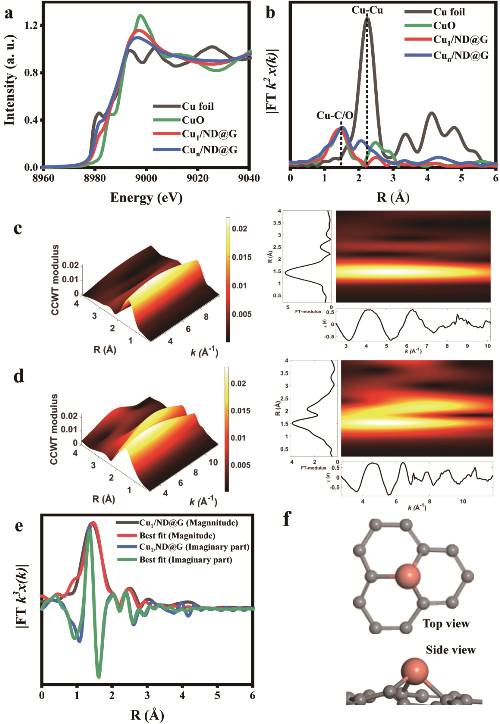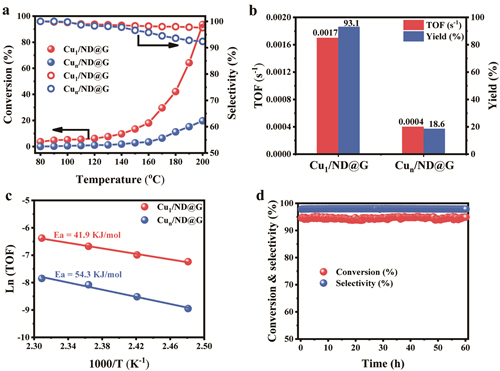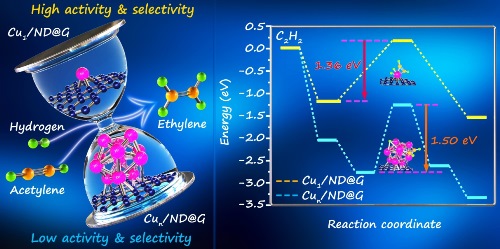[ Instrument Network Instrument Research and Development ] Recently, Liu Hongyang, a researcher of the Joint Research Department of the National Research Center of Materials Science, Institute of Metal Research, Chinese Academy of Sciences, and Ph.D. Huang Fei, and other professors from Peking University, Martin, a researcher at the Shanghai Institute of Applied Physics, Chinese Academy of Sciences, and Hong Kong University of Science and Technology Professor Wang Ning and other team work together to make new progress in the efficient catalytic selective hydrogenation of acetylene in the stable atomic-scale dispersed Cu catalysts. The relevant research results are published online in Nature Communications.

Selective hydrogenation of acetylene is one of the important catalytic reactions in the process of industrial production of high molecular polymers. How to selectively hydrogenate acetylene to ethylene and avoid further hydrogenation of ethylene to ethane is a major problem that needs to be solved urgently. Liu Hongyang led the team in recent years to research on new nano-carbon materials supported metal catalysts (ACS Catal. 2019, 9, 5998; ACS Catal. 2017, 7, 3349; Angew. Chem. Int. Ed. 2015, 54, 15823). In the previous research results, it was found that the atom-level dispersed single-site Pd catalyst with stable nano-graphene is excellent in catalytic activity and selectivity in acetylene semi-hydrogenation reaction (J. Am. Chem. Soc. 2018, 140, 13142). For the first time, the atomic-dispersed single-site Cu was anchored to the defect-rich nanographene carrier (Cu1/ND@G) and characterized by spherical electron microscopy and X-ray absorption spectroscopy. The atomically dispersed copper atoms are stabilized at the graphene carbon defect sites by bonding with three carbon atoms on the carrier defects. The atomically dispersed Cu1/ND@G catalyst has significant acetylene hydrogenation catalytic activity and ethylene selectivity compared to the conventional cluster Cu catalyst (Cun/ND@G). The density functional theory (DFT) simulation calculations show that the atomic-dispersed Cu catalyst Cu1/ND@G can effectively promote the activation of acetylene in the acetylene hydrogenation reaction compared to the cluster Cu catalyst (Cun/ND@G). Dissociation from ethylene. This research work has successfully extended the acetylene high selectivity catalyst from the precious metal Pd catalyst to the inexpensive non-precious metal Cu catalyst, laying a solid foundation for the future design and development of high activity, high stability and low cost industrial hydrogenation catalyst.
The above work has been approved by the National Fund Committee's Major Research Project Key Fund, the National Fund Committee's Major Research Projects Cultivation Project, the National Fund Committee Project, the Ministry of Science and Technology Key Research and Development Program “Nano Special Project†Young Scientist Project, the Chinese Academy of Sciences Youth Promotion Association, and the Institute of Metals of the Chinese Academy of Sciences. The support of the National Research Center for Materials Science in Shenyang and the strong support provided by Shanghai Synchrotron Radiation Sources.




Motocycle parts,High Quality Motocycle parts,Motocycle parts Details, Ningbo Hoteng Machinery Co., Ltd.
Ningbo Hoteng Machinery Co.,ltd. , https://en.boss-goo.com